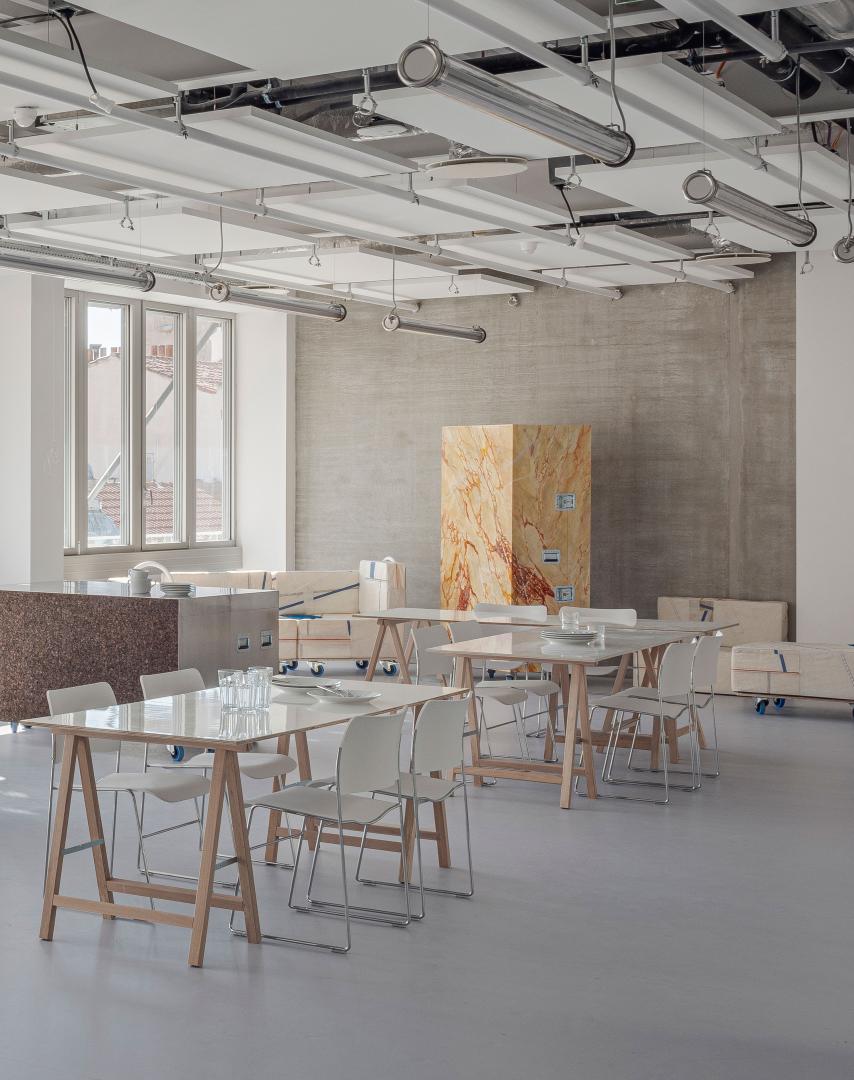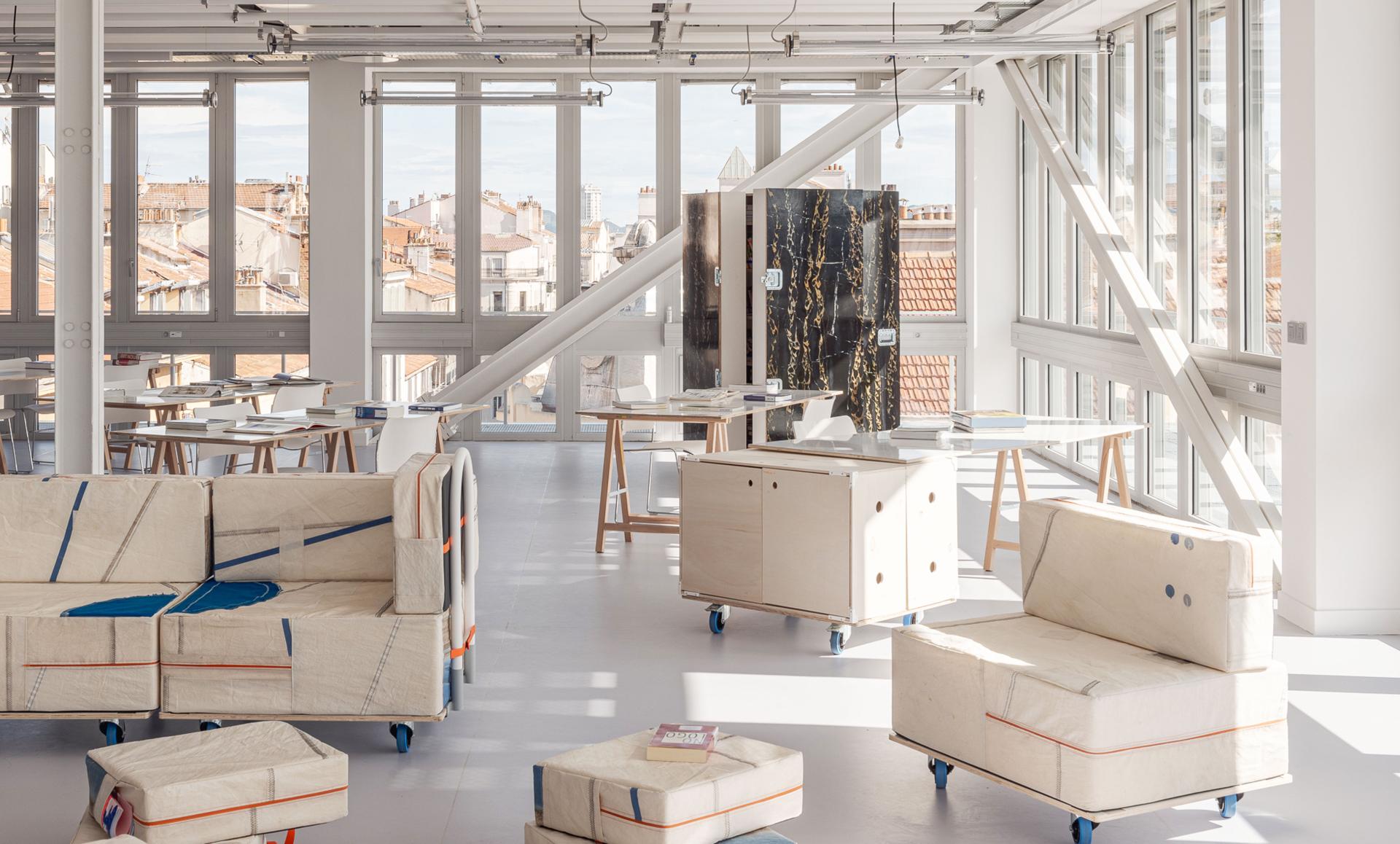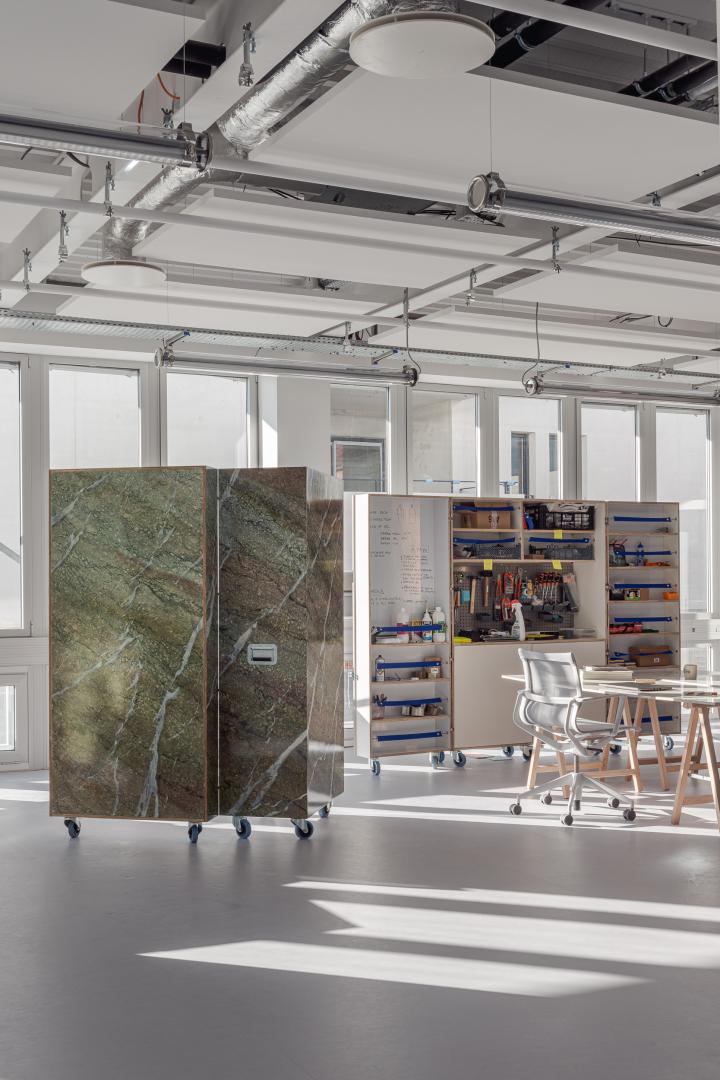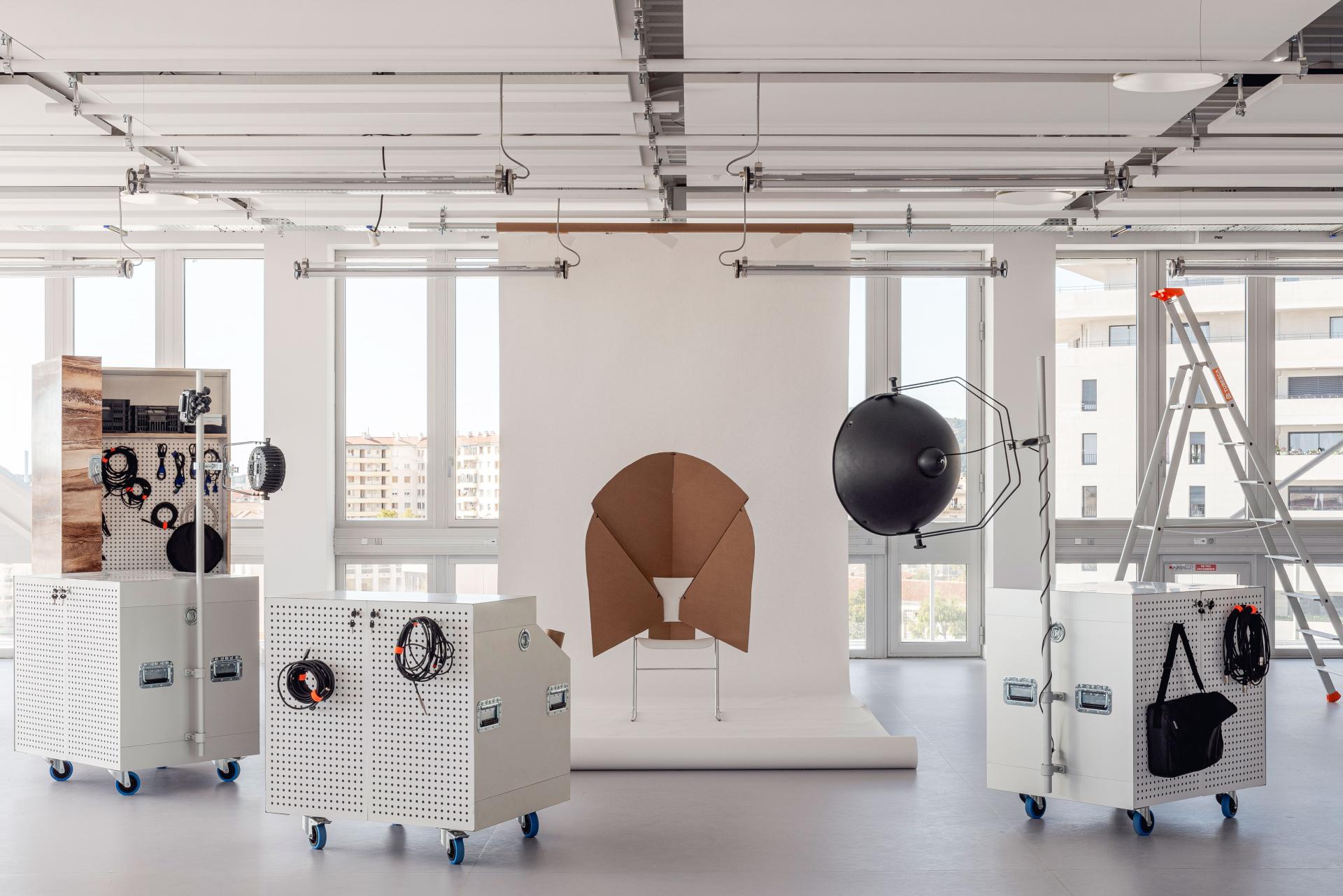Sustainable Furniture System for School
Basic information
Project Title
Full project title
Category
Project Description
Émilieu Studio created, for Camondo Méditerranée design school, a furniture system entirely in repurposed material. Our guidelines: modularity, abolition of the indoor/outdoor frontier, a practical approach to environmental sciences. Through this highly innovative project for a large-scale learning community, we created:
- A circular economical system
- New educational and ecological approaches
- A new aesthetical grammar
- Co-design with the learning community and the inhabitants of the region.
Geographical Scope
Project Region
Urban or rural issues
Physical or other transformations
EU Programme or fund
Which funds
Description of the project
Summary
Émilieu Studio designed the furniture of Camondo School of Design in Toulon, Provence. As designers, this project was the opportunity to explore the transformative and performative power of space and design on education. Furnishing a designer’s school, we wanted to create a learning space that allowed a new education approach towards sustainability in design. A practical approach of environmental sciences.
We furnished a 2-floors, 2000sqm school with a fully custom, modulable, interoperable and movable furniture system. We innovated by designing a large-scale, high-specification furniture system made out of 90% repurposed material (local marine plywood and sails). We created a circuit for waste (weighting scales, storage, repurpose).
Choice was made to root the school in its Mediterranean territory and embrace the local interior/exterior continuum by creating an open, hard-wearing, movable and waterproof system, enabling outdoor projects and the exploration of local crafts.
The school’s interior is a scale-1 playground, enabling exploration on all axes, like the technical grille on the entire ceiling. Every design choice becomes a learning surface. The school is a moving landscape of exploration. Detailed custom maps of local scales ornate the interior and are fully annotable for better collaboration. The school is as much a matrix of multiple potentialities as it is a product of its environment.
We innovated in upcycling techniques and dared to rehabilitate faux, thus avoiding extractivism of rare materials and displaying a library of local minerals.
This educational project highly innovates in rethinking the entire mainstream process of designing and furnishing a large-scale learning space in circular economy. It articulates:
- Sustainability and circular economy in a large-scale project
- Creation of a new aesthetics grammar – ecological and educational
- Inclusion of students in co-design and civil society through outdoor-school.
Through space, we learn.
Key objectives for sustainability
The main objective in sustainability was to design and produce an entire system of 100% eco-conceived, movable furniture, for a 2000sqm design school. From the interoperable desks and boards to the trash cans through kitchen sinks, everything had to be made out of either bio-based or repurposed local material. The local production also had to apply to savoir-faire, mainly craft in upcycling.
This main objective had two mandatory sub-objectives:
- Specifications. Materials had to be hard-wearing; waterproof; the interoperable desk and board system had to be white board allowing writing and erasing with a standard board pen.
- A movable and modular furniture system. The soft investments are meant for the learning community to be able to modulate and reassemble them in another configuration, inside or outside the school. Goal is to lower significantly the need of units by being able to relocate them. As such, furniture is not a sleeping stock for pre-programmed functions, but modular and alive, welcoming the functions to come and to be invented.
Those goals – eco-conception, circularity, local material and savoir-faire, modularity, mobility – were met thanks to an integral custom methodology, as developed in the question below about innovation in industrial systems. With local and socially conscious partners, we were able to create a custom furniture system, modular and transportable, solely out of reused local material (90%) or bio-based or local material (~10%). We thought of reversibility and everything is made to be disassembled to pieces if needed.
The scale of this project is absolutely innovative and exemplary. It proves it’s possible to sustainably furnish a 2000sqm school with high specifications, only using repurposed and reusable local material and savoir-faire. To help disseminate our approach on sustainability, we developed an open-source methodology (as explained in the question below about dissemination).
Key objectives for aesthetics and quality
We believe in the transformative power of a sustainable learning space in teaching how design and sustainability come together. Thus, the objective was to rethink the aesthetical approach in interior design and build a new aesthetic grammar, educational and ecological.
We had two difficulties:
- Aesthetic couldn’t come across functionality, but prioritize functionality over aesthetics would have been in contradiction with the objective.
- We had to showcase the wonderful raw materials of the Provence region to the students; but our radically sustainable approach couldn’t allow extractivism.
Our only leeway was surface.
We rehabilitated faux. Pierre-Yves Morel, decorative painter, created trompe-l’oeils on the huge pieces of movable furniture shaping the space (cf. below and catalogues). They display local marbles, creating a scale-1 library of material.
We used the local, versatile black cork for ornamentation: sound-proofing, collaborative board…
Bins are aesthetically and functionally asserted in the furniture system, with their weighing scales and repurposing system.
We designed 2,4 m x 2,4 m annotable maps with local cartographers, graphists (Formes Vives) and landscapist (Alexis Feix). They display the scales of Toulon, the region, and the Mediterranean Sea. No Camondo sign at the entrance: only maps to see. The school is a map, embodied in its region.
The objective is met by three criteria: aesthetics reasserts the value of upcycling craft; caused no extractivism; it serves an educational purpose where functionality and aesthetics stem from each other. A unique aesthetic grammar, educational and ecological, determined by the locality of the school.
In its 19th century golden era, faux mocked the vanity of luxury. In the 21st century, faux still reclaims exclusivity, for a new reason: exhaustion of natural resources. This project is exemplary in updating decorative arts into our global reality. For an inclusive, educational, sustainable Art-Déco.
Key objectives for inclusion
Furnishing a design school, our two main objectives were to co-design with the learning community – students, professors – and a result allowing them total autonomy in inventing new functions and updating the system.
Our problematic was that we had to design and furnish before the students were here.
The solution we found was to not design pieces of furniture per se, but rather custom standards of an entirely interoperable system, suiting and following the needs of the entire learning community.
The first project of each student is to build a personal box. Plans and handbook are open-source and it is custom-made on-site, including via 3D printing. Throughout their time at school, students improve and augment their boxes to fit their needs and projects. The entire interoperable system is made for the boxes to fit and guarantees mobility and interoperability, serving different functions and modulating space and furniture (more infos in the question about industrial innovation and real-life examples in the attached catalogue). A technical grid covers the entire ceiling of both floors and 2000sqm to allow the community to play in every dimension.
The double objective of co-design and evolutive design seems to be met. The students, for two years now, continuously augment their boxes and invent new configurations and uses to the furniture system. To the point where the school made an order for new units to build a mobile learning centre.
This is exemplary because we co-designed with the community a pedagogic and sustainable furniture system, making us ask ourselves: “how do I build space?”. We use interior architecture as a way to teach personal and collective initiative, an innovation at such a scale.
In partnership with Camondo School, we now edit the furniture for other communities or private individuals. The remaining percentage after retributing the different partners in production goes to the scholarship funds for equal opportunities of Camondo School.
Results in relation to category
Our category is: The need for long-term, life-cycle thinking in the industrial ecosystem.
Our objective was to make grand-scale, custom and high-specs interior design enter the circular economy.
Our methodology is integrally circular – we explain in more extend in the question about industrial innovation. At the beginning of the cycle, we had a conception phase where we determined the specification with the school direction. Then we had a second phase of sourcing our repurposed raw material, that made 90% of our furniture (repurposed maritime plywood, sails), and a sourcing of bio-based and local additional material. Production phase was made on-site by local and social companies or directly by the learning community, using the school’s tools and 3D printing. The exploitation phase is running now. When time comes, every unit of furniture is designed to be easily disassemble and the material reused, fixed or repurposed.
The objective of large-scale, high-specification circular interior design project is achieved.
Concerning the functionality objective, we don’t have an evaluation report yet, but we have a proof of work. The furniture system is appropriate inside as well as outside in many different configurations. Students augment the furniture system, e.g. creating a low-tech kitchen out of it (cf. catalogue for more). We had a new command of units: the school wants to build a movable learning center using student boxes.
A part of the furniture system was acquired by the Musée des Arts-Décoratifs in Paris for their collection. This proves a significant impact of the project on the design industry, recognized by the institution.
About the impact of our idea that space itself in the learning environment is transformative and powerful tool towards the education to the environment, it is new and still is to be developed – outside of learning spaces for yougnsters. But we do what we can to push the idea (cf. last question).
How Citizens benefit
Civil society in its broad sense is not particularly involved in the school; therefore, not particularly involved in its furniture.
But the goal of a school is to educate citizens, and these design students are awakened to the responsibility of ecological thinking and design. As such, they are directly involved in the design, as co-designers, and implementation of the project, as users. And the entire movable furniture system is made to encourage them to explore the region they live and study in.
Our concrete goal in citizen and civil society involvement was to create connections were made between the learning community and the region.
This goal is met since the students, actually using the furniture system outdoor, created bonds with the inhabitants of Toulon and started a consultation service for the people in Toulon wanting advice on interior architecture.
The furniture system has a direct impact on binding the learning community and its region as well as dialog with civil society.
Physical or other transformations
Innovative character
The innovations are:
- A movable, indoor and outdoor large-scale school furniture
- A complete, high-specifications furniture system in repurposed material for a large-scale community
- An integral methodology for ecological educational purposes through a pedagogical interior architecture.
Usually, conception and production are separated. We gathered them. The project follows through the entire process for a cohesive pedagogic purpose where aesthetics (conception), functionality (specification), co-design (production) co-create a performative ecological learning space.
We inverted the mainstream process in such projects. When conception usually comes from moodboards and duplication of pre-existing projects, we didn’t benchmark images or concepts. We instead sourced a local deposit of reusable material, large enough and meeting the school’s unique specifications. A hard-wearing reusable local material, waterproof, movable, allowing board pens. The whole projects depended on such a deposit and the versatility of its uses.
Once it was found– buried offcuts of maritime plywood from a nearby factory – we designed an interoperable system of furniture that could be built almost entirely out of this material (details in the attached catalogues). It was built by a local carpentry company, DSF Crew, auto-organized as a gender-parity cooperative. The cover of the cushion are reused sails from local sailing clubs. Aluminium and inox are from a local factory and the inlays made out of bio-sourced local black cork.
The student boxes fit the standard of this furniture-system: the trolley. We didn’t program functions to the furniture, but opened the possibility to a multitude of functions. Extensions transform trolleys into whiteboards, desk with wheels, couch units with custom cushions... The possibilities are infinite and the needs anticipated (pockets, storage…). Non-exhaustive examples of boxes and furniture configurations by the learning community in attached catalogue.
Learning transferred to other parties
We aim to disseminate as much as we can our methodologies, plans and ideas.
Dissemination via open-source
The student boxes are open-source and plans given to the students for building, improving and augmenting.
Duplication:
The school is autonomous in the large-scale duplication of its furniture system.
Communication:
- We communicated on the project in extensive articles on Linked-In among other designers; and in communications in international design and interior architecture magazines (Frame Award in interior architecture for 10/2021, Fubiz, ArchDaily). We are in contact with other partners in media for exterior communications (see links below).
- We did numerous talks on this project. For instance at the Cellule Bâti Scolaire et Espaces d’Apprentissage, a research organ of the French national education. At 19M, institution for the promotion of artistic crafts and professions.
- We had a partnership for exhibitions during the Design Parade in Toulon with Villa Noailles, the municipality and the region administration (see links below).
- We documented the whole process in our catalogues, that you will find attached to this application.
- We documented the whole process on our website (see links below).
Edition:
Camondo School partnered with us to edit a part of the furniture system in order to make it accessible for other learning communities, or private individuals. For the first time, a design school is engaging in the process of edition and promotion of design furniture. A percentage of the profits goes to the equity scholarship fund of Camondo School. We show full discolure on the costs breakdown to counter the opacity of the design edition for made-in-France design. (see links below).






